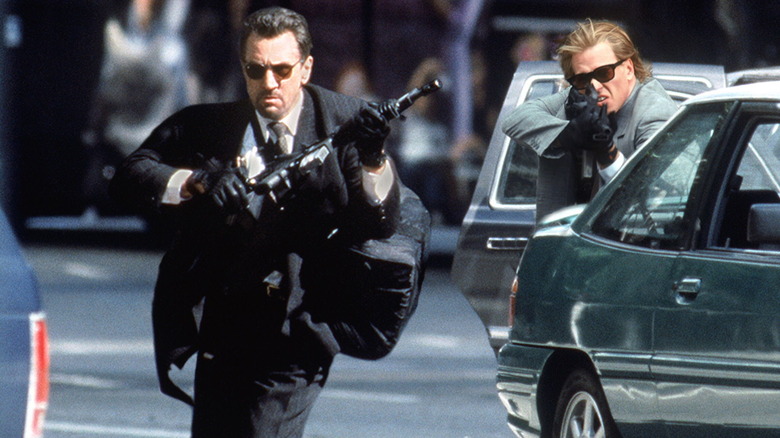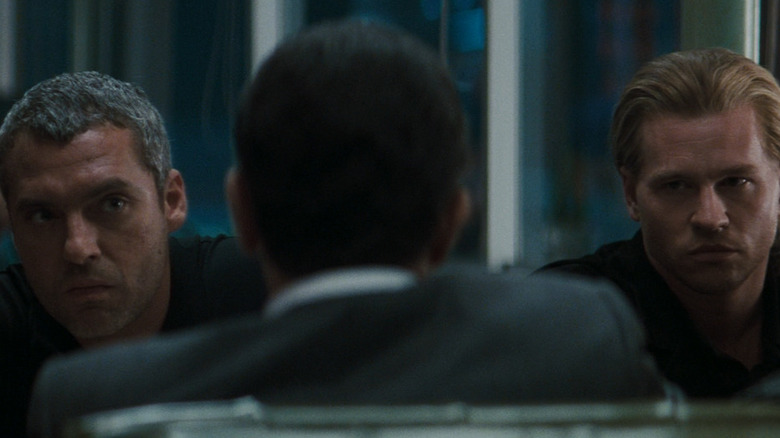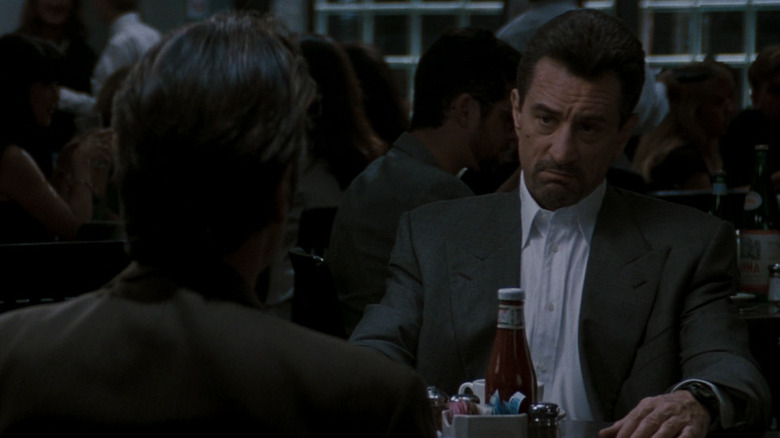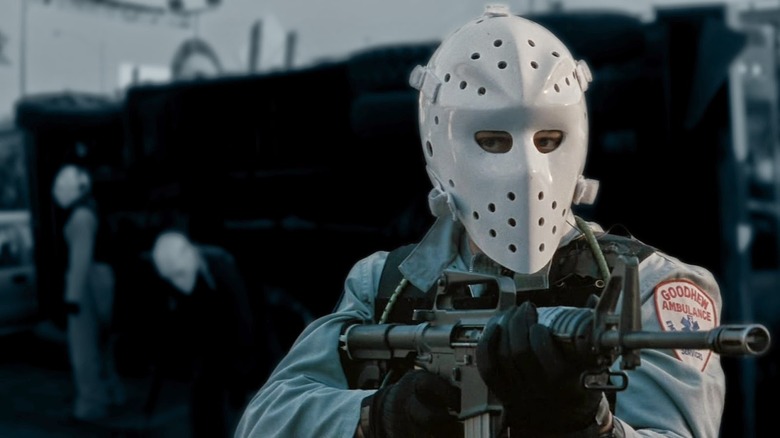The Real-Life Bank Robbery That Inspired Heat
One cop, one robber, two cups of coffee; it's the set-up for that legendary diner chat in "Heat," one of the most famous scenes in modern movie history. In a three-hour crime epic punctuated by teeth-rattling shootouts, this quiet conversation is one of the most riveting moments in the whole film. Not only is it expertly written and shot, it went down in history as the first onscreen meeting of two acting heavyweights, Al Pacino and Robert De Niro.
It's fascinating to see these two great actors playing off each other's distinct style. "Heat" has Pacino on the brink of "Hoo-ah!" self-parody, yet it suits his character as Vincent Hanna, the intensely driven LA detective on the trail of De Niro's methodical professional crook, Neil McCauley. Pacino's larger-than-life style is counterbalanced by De Niro's low-key, considered approach. Not only are the two characters opposite sides of the same coin, but the actors are as well, making the scene even more engrossing.
It's ironic that in this first meeting of the two Hollywood legends, director Michael Mann chooses not to capture them in the same frame with a two-shot, leading to rumors that the actors had filmed their half of the conversation separately. Instead, Mann alternates over-the-shoulder shots as they speak, providing a hypnotic rhythm and involving us in the conversation. They talk quietly, respectfully, sizing each other up and finding a common bond. To emphasize the importance of their words, Mann drops out the background noise from the busy diner. In another world, they could be friends, but they both know that the next time they meet each other, only one will likely survive.
In a film packed with superior versions of well-worn tropes, this is the grown-up equivalent of that hackneyed scene in movies where the villain says to the good guy, "We're not so different, you and I." It's such a movie-ish movie scene that it never occurred to me that "Heat" was based on a true story. Then I discovered that two decades before cameras rolled, a real cop and a real robber sat down for a very similar conversation.
So what happens in Heat again?
Neil McCauley (De Niro) is a career thief and head of a highly motivated gang of professional robbers. When a loose cannon new recruit guns down a security guard during a daylight heist on an armored car, the crew has no choice but to eliminate the other two witnesses. This cold-blooded act brings LAPD Lieutenant Hanna (Pacino) to the case, who is determined to put a stop to McCauley and his gang.
Meanwhile, McCauley starts a tentative relationship with a fellow lonely heart, Eady (Amy Brenneman), going against his ethos of never having anything in his life that he can't walk away from in an instant. This leaves him exposed as he plans one last big job as Hanna and his team close in.
On paper, it's a pretty simple story featuring several basic tropes of the crime thriller. There is the psycho loose-cannon who even the most meticulous professionals in movies always end up hiring, and the one last job before the protagonist leaves his life of crime behind to settle down with a good woman ... Pacino was in a similar situation a few years earlier in "Carlito's Way."
What makes "Heat" stand out among countless similar movies is Mann's minute attention to detail and his absolute commitment to the story. Mann sees something mythic in this classic tale of cops and robbers, giving the story plenty of room to breathe and populating it with a large cast of superbly written characters, each with their own hopes and sorrows. To get the details just right, Mann spent time in pre-production riding along with the LAPD, interviewing real criminals, and hiring Edward Bunker, the former armed robber turned author and actor (Mr. Blue in "Reservoir Dogs") to act as a consultant on the film (via The Dissolve).
Meanwhile, his cast took advanced firearms training with ex-Special Forces man Andy McNab. The result was a climactic shootout scene that was so realistic that the US Marines have used it as an example in boot camp (via Task & Purpose), recording live volleys of ammo to make the barrage of gunfire sound unlike anything previously put on film. As a result, the robbery scenes in "Heat" are among some of the most authentic action sequences Hollywood has ever produced.
What was the real-life inspiration for Heat?
The real Neil McCauley was a hardened criminal who spent time in Alcatraz before his release in 1962, when he started putting together a crew and planning a new series of heists. He came to the attention of detective Chuck Adamson, who started tracking his movements. In a moment that inspired Mann to write his first draft of the screenplay that became "Heat," Adamson and McCauley ended up sitting together in a Chicago diner, and found a little common ground during their chat. As Michael Mann said (via Film School Rejects):
"Chuck had respected the guy's professionalism — he was a really good thief, which is exciting to a detective, and he tried to keep any risks to a minimum — but at the same time he was a cold-blooded sociopath who'd kill you as soon as look at you — if necessary... Chuck was going through some crises in his life, and they wound up having one of those intimate conversations you sometimes have with strangers. There was a real rapport between them; yet both men verbally recognized one would probably kill the other."
As Adamson said in The Making of Heat:
"Neil McCauley was 49 years old the day we met and he had already served 25 years in penitentiary. Of that 25, eight of it was on Alcatraz, and four years on Alcatraz in isolation, what they called 'the hole.' Knowing his background as I did, I'm not gonna rehabilitate this man, okay? And I know that going in. So I said to Neil, 'Why don't you go somewhere else and cause trouble?' And he said, 'I like Chicago.' It was real simple stuff. So I said to Neil, 'You realize one day you're gonna be taking down a score and I'm gonna be there?' Then he said, 'Well, look at the other side of that coin. I might have to eliminate you.' And I remember the very last thing I said to him was, 'I'm sure we'll meet again.'"
The demise of the real Neil McCauley
Chuck Adamson was right; he and Neil McCauley would meet again under far less friendly circumstances. Their final showdown was in March 1964 after Adamson and his colleagues had followed the gang for nine weeks. McCauley and three others made their move at the National Tea company in Chicago, just after an armored car delivered a shipment of money to the store. The gang threatened clerks and grabbed the loot ($13,137 in total, the equivalent of almost $120,000 today), before trying to make their getaway by car.
Adamson and his team were already on the scene and three of the gang, including McCauley, died in the resulting shootout. One surviving member managed to escape the trap but was later arrested and sentenced for the crime. The police revealed that McCauley's gang was responsible for several other robberies, from housebreaking to stealing $70,000 worth of tools and cutting equipment (via Chicago Tribune).
Adamson admired McCauley's discipline and professionalism, as in an earlier incident when the thief walked away from a property he'd previously cased when one of the cops waiting for him made a noise – that moment made its way into Mann's screenplay, too. Mann wrote his first draft based on Adamson's experiences back in 1979, and the story made its way to the small screen twice before "Heat" hit theaters in 1995. Elements appeared in the pilot episode of the TV series "Crime Story," while the 1989 TV movie "L.A. Takedown" was a dry run for the real thing just six years later. Mann's determination and patience in getting the story he wanted to tell to the big screen was worth it; not only is "Heat" one of the greatest crime films ever made, but that legendary scene between Pacino and De Niro did perfect justice to the real-life incident that inspired it.



